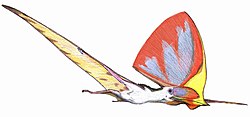| Ctenochasmatids | |
|---|---|
 | |
| Ctenochasma elegans specimen from Solnhofen | |
| Scientific classification | |
| Kingdom: | Animalia |
| Phylum: | Chordata |
| Class: | Reptilia |
| Order: | † Pterosauria |
| Suborder: | † Pterodactyloidea |
| Clade: | † Ctenochasmatoidea |
| Family: | † Ctenochasmatidae Nopsca, 1928 [1] |
| Type species | |
| † Ctenochasma roemeri Meyer, 1852 | |
| Subgroups | |
| |

Ctenochasmatidae is a group of pterosaurs within the suborder Pterodactyloidea. They are characterized by their distinctive teeth, which are thought to have been used for filter-feeding. Ctenochasmatids lived from the Late Jurassic to the Early Cretaceous periods.
The earliest known ctenochasmatid remains date to the Late Jurassic Kimmeridgian age. Previously, a fossil jaw recovered from the Middle Jurassic Stonesfield Slate formation in the United Kingdom, was considered the oldest known. This specimen supposedly represented a member of the family Ctenochasmatidae, [2] though further examination suggested it actually belonged to a teleosaurid stem-crocodilian instead of a pterosaur. [3]












